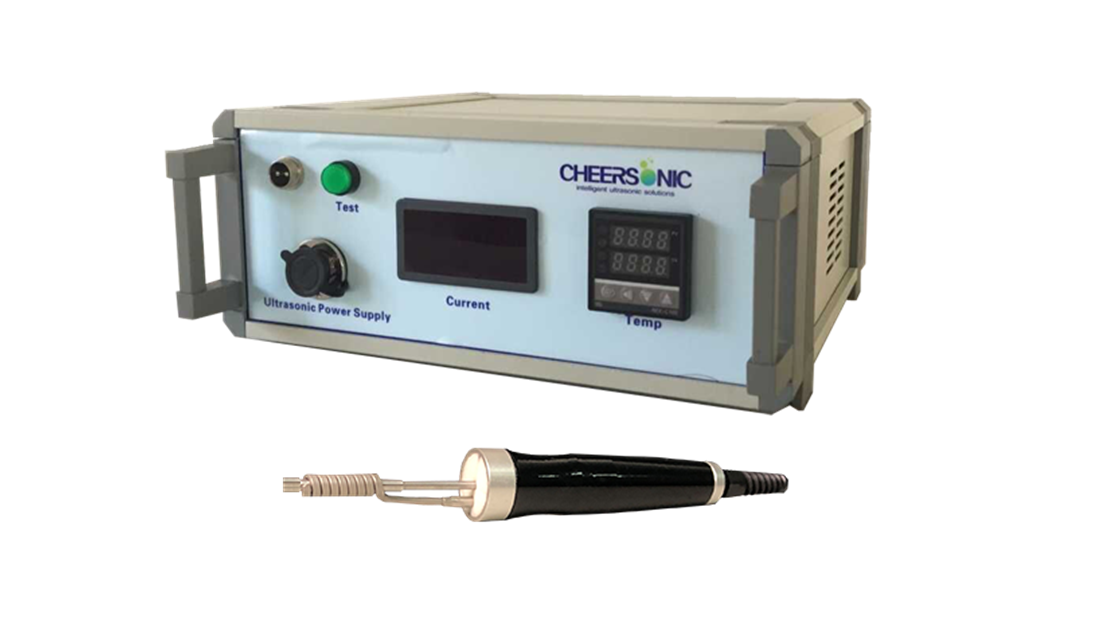Ultrasonic Electric Soldering Iron And Soldering
Soldering is similar to soldering. Soldering is a welding method that uses low-melting metal solder to heat and melt, and then penetrates and fills the gap between the metal parts. Ultrasonic soldering irons are usually used for soldering. Ultrasonic electric soldering iron is mainly used for soldering of materials and has the advantages of environmental protection, energy saving, and convenience. Soldering irons are commonly used for delicate tasks involving electronics and when used on circuit boards. The heating head can heat accurately, so it is especially suitable for the work where excess heat will damage adjacent components in the surrounding area. Iron has a very light weight, so it can be used comfortably for a long time.
Ultrasonic soldering technology uses the energy emitted by ultrasonic vibration to heat to melt the filler metal material (ie solder) to form a joint. You can use a special soldering iron for product processing. This process can be automated for mass production, or it can be done manually for prototyping or repair work. Initially, the purpose of soldering was to connect tin and other metals. However, with the advent of active solders, more types of metals, ceramics and glass can be soldered.

The shortcomings of traditional soldering iron
The oxide film of the processed material has an influence
When using a traditional electric soldering iron for soldering on a metal surface, it is usually necessary to heat it to a temperature above a certain temperature to melt the filler, and even higher temperatures are required for nickel-based filler metals. When heated to these temperatures, the flux or atmosphere that chemically or physically reduces the surface oxides of the metal is essential for the soldering work. In order to “wet” the molten filler metal, make it flow evenly and adhere as a liquid, the metal surface must be free of oxides. Once the molten filler metal is spread or drawn into the joint by capillary action, the heat source is removed to solidify the filler metal and form a bond with the metal.
Need flux
The purpose of the flux is to clean the surface of the base alloy and filler metal and prevent oxidation during the soldering process. The type of flux will affect the way it reacts with the metal being welded and the effective temperature range of the flux. Since the flux is heated and depleted during the soldering process, the amount of flux used will affect whether the solder joints are formed before oxidation occurs. The consumption of flux also affects the final time-temperature curve experienced by the joint during the soldering process. In some cases, nitrogen, argon or other shielding gases are used to help the flux prevent oxidation.
The flux produces visible fumes that are visible during the soldering process. Contact with flux rosin can cause eye, throat and lung irritation, nosebleeds and headaches. Repeated exposure can cause respiratory and skin allergies, causing and aggravating asthma. Certain fluxes contain lead, which can cause serious chronic health effects.
Advantages of ultrasonic soldering iron
Efficient and environmentally friendly
Ultrasonic electric soldering iron equipment can produce high-quality adhesion and clean, tight sealing. There is no filling material and no excessive heat, which means that there is no potential to introduce contaminants or thermal deformation. There are no visible seams between the parts, creating a smooth, visually striking surface. The result is a durable bond that is superior to many other methods of joining parts. Hygienic and reliable sealing makes ultrasonic soldering especially suitable for precision electronic products. The only thing that may limit the use of ultrasonic welding is the thickness of the parts involved. As long as the parts are not too thick, this method is a cost-effective choice.
Eliminate the oxide film on the surface of the processed object
Ultrasonic soldering is a unique process that uses ultrasonic cavitation to destroy the oxides on the surface of the soldering material and bond two surfaces that cannot normally be soldered together. Therefore, ultrasonic soldering does not require additional treatment of the oxide film on the surface of the object to be processed, and it will not affect the soldering effect.
Eliminate bubbles in the soldering process
During the soldering process, due to the melting of the processed materials, bubbles may appear during the soldering process, and these bubbles will affect the final soldering effect. The ultrasonic soldering process is through the cavitation of ultrasonic waves, and eventually the bubbles will die out, which will not affect the entire soldering effect.
No flux needed
Ultrasonic soldering iron equipment does not need to use flux in the soldering process, and some fluxes have great harm to the human body, so ultrasonic soldering avoids the harm to the body to a certain extent.
Direct soldering
Traditional electric soldering iron equipment cannot directly solder glass, ceramics, titanium alloys, stainless steel, molybdenum alloys and other materials, while ultrasonic materials can use their own cavitation effect to directly fuse these materials to achieve soldering. Effect.